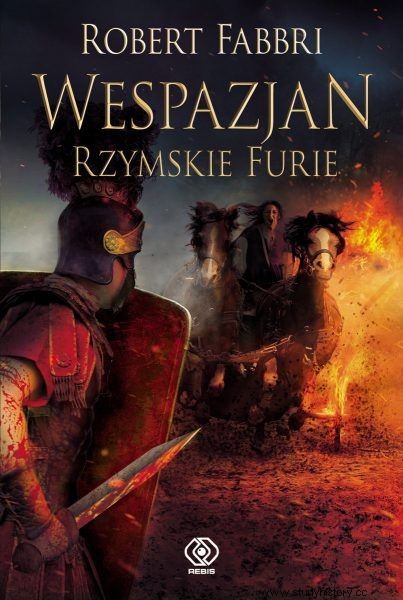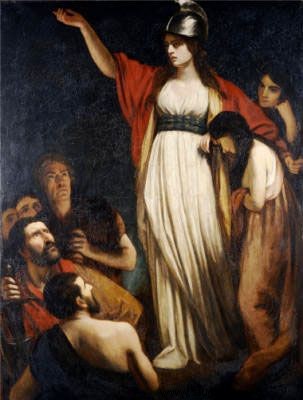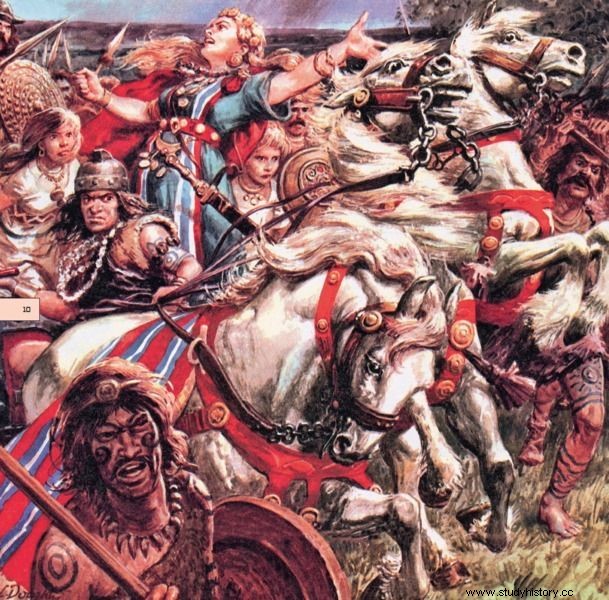It started with money. Or maybe from the body destroyed by the flogging and the disgraced worship of daughters? Then only a scene from Wagner's opera. Boudika - tall, shiny eyes, coarse voice, thick blonde hair falling down to her hips, with a large golden chain around her neck, in a colorful dress. Her arms were covered with a thick cloak fastened with a brooch - the Wagnerian Valkyrie amidst the hostile territory of the Romans in eastern Britain.
This call for freedom led her to a general battle with IX Hispana under the orders of Suetonius Paulinus. In self defense of libertas the queen decided to poison herself (according to Tacitus), or died of disease (Cassius Dio), while her uprising was bloodily suppressed under the watchful eye of the eagle on the banners.
The ideal of a woman on the Tiber
The most recognizable image today of the one who decided to undermine Roman rule remains Cleopatra VII Philopator , the last ruler of Egypt to ultimately fail against the armies of Octavian Augustus.
The Roman ideal of a woman shaped throughout history was associated with the presentation of a certain canon of characteristics. A woman should (according to the Romans!) be beautiful, honest, loving, faithful, modest, meek, pious. In the historiography of the times of Augustus, such women were modeled on Lucrezia (raped by Sextus Tarquinius, son of Tarquinius the Pyszny), and Verginia (forced to marry the patrician Appius Claudius, and then murdered by her own father). Wisdom and moderation, understood as prudent policy while maintaining the traditional role of a woman at the Roman court were represented in turn by Antonia the Younger (mother of Emperor Claudius) and Agrippina the Elder (mother of Emperor Caligula).

The article was inspired by the latest novel by Vespasian. Rzymskie Furie, which has just been released on the market by Rebis
These examples show a slight change in Roman literature in less than 150 years. Titus Livy (64/59 BCE - 12/17), who recreated the image of Lucrezia and Virginia focused on including his works in the program of moral renewal of Augustus . Tacitus, Plutarch, and Suetonius (beginning of the 2nd century), whose works are images of women in the early principate, focused on the Stoic canon of cardinal virtues, popular in the times of Trajan. It was well illustrated by the examples of mothers of emperors or the wives of the Stoic philosophers, persecuted by Nero and Vespasian (Trazea Petus and Helvidius Priscus).
For Publius Cornelius Tacitus, one of the most respected historians during the principate period, the so-called "Zwierciadło" (the author of the term "Tacitus's mirrors" was professor Jerzy Kolendo - see introduction to Germania). They became this mirror image of Roman women in Annals and The Life of Agrykola barbaric rulers such as Kartimandua and Boudika, and the seer Weleda.
Of course, the basic problem in recreating the image of each of these women is the partial nature of Roman sources and the complete lack of written sources authored by the Britons. This image is inevitably distorted, and each of the women reaching for power that, from the Roman perspective, does not automatically receive the stigma of the "royal harlot from Egypt" and must be sui generis "Tool" for the soulless narrative of the winners.
Britanio, Britanio!
Many commanders of the Roman legions, led by Julius Caesar, dreamed of the conquest of the island. A capricious fate, above-average command skills or a favorable political situation meant that the conqueror was the emperor, seemingly least predestined for this - Claudius.
Claudius' mother, Antonia the Younger, even in his youth, liked to joke about the intelligence of her interlocutor, claiming that the person is even stupider than her son. Already at the threshold of his reign Claudius suffered so much from the lack of military achievements that the coins from the years 41-43 show primarily his father's military successes , Druzus the Elder. They were mainly aureuses and denarii with a legend on the reverse DE GERM, depicting a bust of Druzus on the obverse, and a triumphal arch on the reverse, on the top of which a horse statue of the triumphant was placed.
After the conquest of Britain, he would commemorate his victory in the same way. Karl Christ noted that at the basis of Claudius' conquest of Britain lay, inter alia, an attempt to cover up the embarrassing impression of Caligula's attempt to incorporate this territory into the Empire . From the beginning of the 1st century, one of the most important centers on the Island was Camulodunum (today's Colchester), where Cunobelinus, one of the most eminent British rulers, ruled until the 1940s. After his death, his sons (Togodumnus and Karatakus) waged numerous tribal wars, thus creating an opportunity for the Romans to enter their territory.

Queen of Boudika
The invasion took place in AD 43, when four legions under the command of Aulus Plautius appeared over the English Channel , as well as Gallic and Thracian auxiliary troops, which totaled about 40,000 soldiers. The landing was carried out in the region of today's Richborough. The first clashes took place on the Medway River. After the defeat of Togodumnus on the Thames, Aulus Plautius withheld the invasion until Claudius arrived, and only under his nominal command was it possible to capture the Camulodunum. There there was an act of surrender by the leaders of individual tribes, i.e. (king Icenow), Cogidumnus (king of Regnów). By 52 Great Britain was conquered as far as the Fosse Way (South East England).
Boudik in the eyes of historians
In 60 or 61, the Iceni king Prasutagus died, and Nero decided to include his kingdom (today's Norforlk) into the province of Britain. Probably the king, during his homage in Camulodunum, appointed the Roman princeps his heir, thus retaining partial independence. In connection with the transformation, Roman officials were to proceed to consolidate territories, often resorting to terror.
This could be partly due to the ambitions of Nero himself, who believed that the loan given to Prasutagus from Rome (about 40 million sesterces) should be repaid as soon as possible. It is much more likely, however, that Roman officials simply practiced high tax burdens resulting from the construction of the temple of the divine Claudius in Camulodunum and the statue of Victoria clearly attacking the pantheon of the British tribes.
However, the scene later described by Tacitus may have been the flashpoint of the uprising against the Romans as well. The widow of Prasutagus, Boudika, who refused to pay such a high tax, was to be publicly flogged and her daughters were repeatedly raped by Roman soldiers. Certainly, the uprising was initiated by the Icens, but the role of Boudica herself in initiating the rebellion is not clear (even for Tacitus himself!).
In Annals the widow-queen is presented in a dramatic scene of the rape of her daughters, then disappears from the narrative for a while to reappear before the decisive battle. In Agrykola's Life (by the same author) the Queen takes up arms to fight for the freedom of the Icen (or Britain?), and in revenge for the flogging and disgraced body of her daughters.
There are two interesting mechanisms of shaping the image of a barbarian in Roman literature. The first, definitely disgracing the insurgents: the female leader must encourage the Brits to fight for freedom, who cannot afford even a little courage to put on the scale of the freedom of your life. The barbarian woman is depicted here in the "robe" of the Roman virtues of dedication, wisdom and fidelity - in the case of Boudica, allegiance to her late husband, Prasutagus, who prevented their lands from being included in the province.
Tacitus's second procedure here is directed against Boudica. She is depicted as a desperate and battered woman. In the narrative, Tacitus becomes a kind of example of Roman practice against those rebelling against the Roman authority extarne gentes (to the outside nations). The narrative of Tacitus, who wrote in the time of Emperor Trajan, is perfectly matched by a passage in a much later work by Eutropius, who commented on the conquest of Dacia in 106 with the sentence: Dacia (...) viris exhaust ("Dacia stripped of men").

Boudika became a symbol of the brave queen
The third account of Boudica comes from a much later historian, Cassius Dio, who wrote his Roman History in the middle of the 3rd century. It was he who was the author of the image of Boudika quoted in the introduction to this article. This image, which for German romantics would certainly be a reason for pride and nostalgia, for the Romans was nothing more than a caricature of a woman who, with the same fiery speech on the Tiber River, would be laughed at , by both men and women (the latter rarely saw their social position as warrior amazons).
The Greek Cassius Dio (he came from Bithynia, but wrote and probably thought in Greek) smuggled into the image of Boudica another aspect of the reality in which he had to write. This is a profound critique of freedom, which, two hundred years after the advent of the principate, is definitely lacking. Boudica, therefore, is used here as an advocate of the senatorial thought of the difference between freedom and slavery, which only a free-born (and the barbaricum territories, which Britain was not, in Dion's time, were associated with a kind of freedom from the corruption of Rome) is able to fully understand.
Not only Cleopatra!
Boudica's uprising collapsed, and the leader herself either swallowed the poison or was plagued by disease. The topos of poison (Tacitus) in the eyes of Wagner obviously adds to the glory of her death, but for a Roman historian it is a cowardly escape from Roman justice, similar to that committed by Cleopatra.
Perhaps that is why Cassius Dio (who idealizes the image of the queen a little more than Tacitus) is in favor of saying that she died as a result of an illness. The Queen of Iceni was not alone in the pantheon of those against whom the Romans waged their weapons of historiography. A little earlier, in 49 AD, during Claudius' invasion of Britain, Kartimandua became Queen of the Brigades. During the uprising, Boudica remained neutral and it is possible that her territory did not share the fate of the Icens.
In 69/70, an uprising pacified by the Romans broke out against Kartimandua. The queen herself obtained shelter from her liberators. The initiator of the uprising was Venutius, the former husband of Kartimandua. Tacitus Kartimandua, mentioned many times above, received much praise, for example for his noble attitude in handing over the rebel Karatakus to the Romans in AD 51, thanks to which the conquest of Britain could proceed more efficiently.
However, this is where the praises from Tacitus end. He recalls that Kartimandua gained her power and position through treason and deception against her lawful husband. Tacitus gave Kartimandua a kind of historical destiny for the fall, because from the point of view of the ideology of power in the second century, excessive happiness resulting from gaining power in an unauthorized way leads to pride, and this leads to fall.

The article was inspired by the latest novel by Vespasian. Roman Furies , which has just been released on the market by Rebis
On the grounds of woman's virtues, Kartimandua also lost to the exemplary Roman woman. Treason, especially in marriage, is an unforgivable crime. As if that were not enough, Kartimandua, who had given up her husband, adopted a new man named Wellokatus on a "contractual marriage" basis only to make him co-rulers. This man came from the bodyguard of Venutius, which must have been an additional cheek for the betrayed man. So once again the woman was used by Roman historiography as a tool of political criticism , this time directed against the Emperor Vespasian, who, according to Tacitus, should not allow an asylum for the Queen of Brigants that resembles an Eastern despot, led by the Queen of Egypt, Cleopatra.
Bibliography:
Sources:
• Dio's Roman history, trans. E. Cary, Harward University Press, London 1955.
• Liwiusz Tytus, The History of Rome from the Founding of the City, trans. A. Kościółek, ed. M. Brożek, Warsaw 1968
• Tacyt Publiusz Korneliusz, Annals, trans. S. Hamer, Warsaw 1939.
• Suetoniusz, Lives of Caesars, trans. and comp. J. Niemirska-Pliszczyńska, Wrocław 1972.
Compilations:
• Christ K., History of the Roman Empire. From Augustus to Constantine, trans. A. Gierlińska, Poznań –Gniezno 2016.
• Ferris I., Enemies of Rome Barbarians through Roman eyes, Sutton publishing limited, Sutton 2003.
• Ferris I., Hate and war. The Column of Marcus Aurelius Stroud, Gloucestershire, 2009.
• Goldsworthy A., Pax Romana, trans. N. Radomski, Poznań 2016
• Kehne P., "Woman's power" among neighboring peoples in terms of Roman historiography, trans. L. Mrozewicz and M. Ilska, Poznań 2002.
• Kluczek A., The image of the "alien-enemy" in monetary iconography. An example of coinage, in:Greeks, Romans and their neighbors, under ed. K. Nawotka and M. Pawlak, Publishing House of the University of Wrocław, Wrocław 2007.
• Mikocki T., Zgodna, pious, fertile, modest, beautiful:propaganda of Roman virtues in Roman art, Wrocław 1997.
